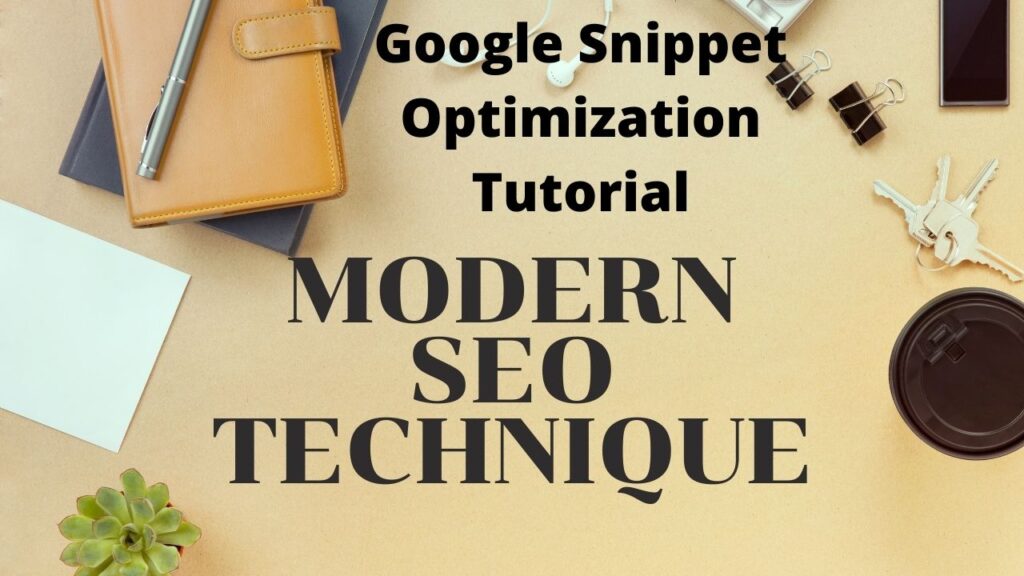
The Google Snippet Optimization technique is a relatively new concept to the SEO world, but it has been around for quite some time. If you’re unfamiliar with the Google Snippet Method, keep reading to find out more. There are many different ways to optimize Google for featured snippets, but there is only one way to gain the full benefit of Google’s snippets. If you want to know how to make Google work for you, read on!
Being the featured Snippet translates into instant and lasting brand exposure from Google or Microsoft, or Yahoo. Google, with its 92% of organic search traffic, is the biggest and most powerful.
The Google Snippet is fulfilling the easy reference for a search query on the Google search page. It means the Snippet displays a short description and then a link to the full definition. Paragraph snippets are the most common. They try to provide searchers with a direct answer to their search (query). Google Snippet gets placed near the top of Google organic search, usually on the first page in search. Hence Google snippet optimization is essential to get top page placement for any targetted keyword search.
We’ve tested it dozens of times in our articles to vie for Google Snippet ranking. Snippet ranking will get you page one placement, critical for driving traffic to your website. It’s a vital part of our google ranking strategy for every piece we write. Today we’re going to give you the basics of what we’re doing to win with snippet optimization.
SEO is doing 95% of the work of getting your content to show up on Google. One way Google has refined its search method is to make suggestions for common searches. As part of its expanding knowledge base, Google has built into the system the mention of common related keywords. With a data set of over 5 billion daily searches, it has a massive information base from which to draw. As a content writer, all you need to do is enter a keyword several other longtail keywords, and google autofill will show you the high volume searches related to your query. See this related article:
Writing a blog post could be taking you up to six hours. Still, if you don’t spend just a few minutes creating content specifically designed to win the Google snippet, it means you’re losing and an army of potential buyers.
Few statistics about Google Snippet

Seventy-four percent of searches will have a featured snippet on them, so everybody has been focused on backlinks and the weird process for keyword research, and all other SEO stuff. Instead of overreliance on backlinking, we’ve been focused instead on winning those Google snippets.
In this article and every bit of content we write, long syle or short, we rely on a targeted answer style.
Everybody else is spending hours writing their blog post. They just press, publish. If you take an extra five minutes and finish out your article with Google snippet optimization, then you too can complete for the prized Google Snippet.
Our big secret is that instead of creating a summary snippet at the end of the article, we begin with the summary and let the item take shape around the Snippet content. Similar to an engineer doing logic walk thru a problem. We start with the pain and define the question on each level that it may exist. Once we have identified a problem, we spend the rest of the duration of the article refining and flushing out answers to all the questions surrounding the issue.
Because of the level of detail, the complete and systematic method we have reviewed and written about the problem, Google will reward us with a higher ranking. If the blog is readable and useful, then that also will boost rankings. Other pages organically may beat our page in the rankings, but because we could distill the problem and solution down to the best two or three-sentence summary of the topic, that’ll put us on Google’s first page.
- The four types of Google Snippets are available. First are Paragraph snippets. Paragraph Snippets, the most common snippet type, and what we’ll focus on in this article.
- Second, my partner, Kevin’s favorite, Numbered list snippets, tends to go viral as everyone loves a top 10 list. Google highly values List Previews see this article:
- Bulleted list snippets and Numbered lists can be used to lead Magnets to grow your prospective buyers’ lists.
- Table snippets are not as shareable on social media, but they contain and summarize much data at a glance.
Paragraph snippets follow these parameters, so format strategically.
- More than 50% of the answer snippets come from the first 500 words of the article. The takeaway is, get right to the point.
- 20% appear between 500 and 1200 words of content.
- 4% are from between 1200 and 2000 words into the article.
Even if other pages organically would beat your page in the rankings because you wrote the best two Or a three-sentence summary of the topic, that put you on Google’s first page.
How to win featured snippets on Google?
Winning Google snippets may seem too hard. One way to gauge competition for a keyword is to search. If most of the posts are comments from forums, you know that it’s possible to win the Snippet and rank high for the keyword or longtail keyword. That, my friends, is just one method to anticipate the competitiveness in your niche.
Incorporate a few techniques when writing content for your blog. Eventually, you can win the coveted snippet spot. So what are the strategies you need to follow to win google featured snippets?
- We are setting up a rapport for the Answer snippet.
- Targetted Answer Paragraph.
- Formatting the Answer Paragraph.
- Standalone Answer Paragraph.
- Wikipedia style answers.
See the explanation of each below.
Setting up a rapport for the Answer Snippet:
In a blog post, the first few sentences should be teeing up the content and establishing a report. You’re saying I have the answer to this question: you’re providing additional context around the answer, and so what does that tell Google?
It says: Hey, we’ve got some knowledge of the problem and the answers coming in the next sentence or paragraph.
What we used to do is we used to restate the question right before the answer, and for a while, that was effective. Keep in mind, don’t weirdly repeat the question. Instead, restating the problem is tells Google and the reader, “This is what I’m about to talk about.”
Targeted Answer Paragraph
An answer target is an answer to the main search query that we write. It’s formatted and written in such a way to encourage Google to use it as the Snippet. There’s not like some secret, like meta tag or something you can use to alert Google to take it as Snippet. Google’s AI engine knows that this is supposed to be a snippet.
Write in a way that attracts Google to use your content.
- When you designed your answer paragraph with specific parameters, even your article has 2000 or 3000 words, and Google AI picks your answer paragraph along with a few others from your content. We encourage you to begin with the answer target. In other words, start with the problem in mind. Understand the answers. Write for your audience, understand their needs, their pain points. Your content should revolve around answering the questions that revolve around keyword-rich phrases. Creat attention grabbing headlines, structure your posts, and use imagery, metaphor, and symbolism—post snippet worthy material on social media. One viral campaign can completely transform your business, authority, and reputation.
Formatting the Answer Paragraph.
Format them to stand out when we make these answer paragraphs.
Answer each question concisely, don’t ramble. Be factual and well organized. Try to answer several related questions at the same time. Organize both your questions and any eye-grabbing images. Be sure to rename each image name the same as the article title. Check systematically and periodically to see how you are doing.
It can be as simple as just making that short paragraph. It should be bolded. It’ll help it stand out for the reader, excellent for user experience. As I write other content, I always bold statements to emphasize and help the reader skimming the content.
By the way, it’s nice to be able to find your answer very quickly. When you bold words, sentences, or phrases, Google knows this is essential material and puts a tag around it. It is a standout content. The AI sees it, the user sees it, and if it’s relevant content, it’s more likely to be featured.
Standalone Answer paragraph
But we see places where Google is paying attention to how that particular text you make as an answer target is formatted to decide what goes there. Think of a standalone paragraph is a miniature essay. Like an essay, it has a clear beginning, a middle, and an end. Just like in school, begin with a topic sentence that expresses its central point. We like to approach this phase as an engineer comes a problem. What are all of the questions that relate to the problem? Then we try to answer all the questions. If we can answer multiple questions within one answer, we’ll seek to do that.?
Be sure that that answer paragraph is a standalone answer, on point and concise. If the topic sentence is too broad, you will not be able to answer in one section. Niche down until it’s just right. Take the lessons you are learning currently and rewrite some of your old content that is not getting traffic or the traffic volume you think it deserves.
Wikipedia styles of answer
The next one is to write the answer in styles like Wikipedia or an encyclopedia. I meant your response should be more formal. Wikipedia style should not have an attitude or personality built into it. You at the reader’s service and are focused only on serving up information as clearly as possible.
Summary of the Google Snippet Optimization
Here once again, I am summarising for a better picture. Though four types of Google snippets are there, Paragraph style snippet winning 50% of spots. So to get a place into paragraph snippet, you need to do the following,
- Build a rapport with the answer by restating the main question.
- Write the answer paragraph by following with the restated question.
- Format your answer paragraph with bolded text. It makes your paragraph standout.
- Write an answer in standalone. Your answer paragraph should start with a noun, and it should not refer to other sections for the part of the solution.
- Write your answer in Wikipedia style. It means you don’t want to show your personality or slang in the response. It should be more formal.
- Graphically demonstrate after writing your description that graphic elements enhance the search strength by including information-packed graphical or animation elements in association with the answer paragraph. See
In summary, two to three sentences are the content Google wants to show as a snippet. Like Google, view user experience as your top priority. To stay on top of searches, Google needs to continue to create an environment that is fast, easy, and to the point.
The content you are creating to post on your blog should maintain the same standards.
Information that is on topic and to the point is best for users. Now you see what goes into Google Snippets, it’s time to move on to the action. Before publishing, review your blog post and see what content is Snippet worthy. Considering repurposing that paragraph and posting it on social media.
Format content specifically so you can compete for the Snippet. Place the Snippet paragraph toward the beginning of your writing. Let your entire blog or article evolve around and support the summary of the Snippet. Over time, you will get into the habit of beginning with the Snippet as part of your outline. Remember, begin with the end in mind.
Complete knowledge of the problem and a thorough job of answering all the questions related to the problem is the key. Writing with the Snippet in mind as part of your outline and formatting will improve your odds of getting the prized Snippet.
Be comfortable learning as you go. You’re not going to be a great writer when you first begin. Like anything, you’ll improve, and you’ll get better organized, both with your article content structure and your ability to write content that ranks and gets snippets. Merely an awareness that there is special formatting will instantly give you an advantage over your competition.



